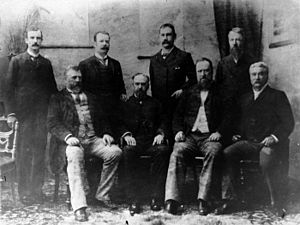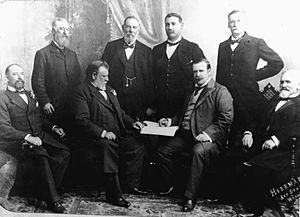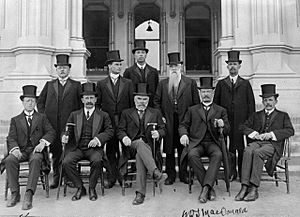Liberal Government of New Zealand facts for kids
Quick facts for kids The Liberal Government |
|
|---|---|
| Ministry of New Zealand | |
| 1891–1912 | |
| Date formed | 24 January 1891 |
| Date dissolved | 10 July 1912 |
| People and organisations | |
| Monarch | Victoria Edward VII George V |
| Governor | The Earl of Onslow (1889–1892) The Earl of Glasgow (1892–1897) The Earl of Ranfurly (1897–1904) The Lord Plunket (1904–1910) The Lord Islington (1910–1912) |
| Premier Prime Minister (from 1901) |
John Ballance Richard Seddon William Hall-Jones Joseph Ward Thomas Mackenzie |
| Member party | Liberal Party |
| Opposition party | Conservatives Reform Party |
| Opposition leader |
|
| History | |
| Election(s) |
|
| Legislature term(s) |
|
| Predecessor | Continuous Ministry |
| Successor | Reform Government |
The Liberal Government of New Zealand was the first government in New Zealand's history to be organized around a political party. It was formed by the Liberal Party and started on 24 January 1891. This government ruled New Zealand for over 21 years, until 10 July 1912. It is still the longest-serving government in New Zealand's history.
This government is famous for making big changes to society and the economy. For example, they introduced the Old Age Pensions Act and gave women the right to vote. One historian said their policies were "a revolution in the relationship between the government and the people."
Contents
What the Liberal Government Did
The Liberal Government introduced many new laws and policies that changed life in New Zealand. These changes helped workers, improved health, supported families, and boosted education.
Helping the Economy and Workers
The Liberal Government focused a lot on making working conditions better and supporting the economy.
- Protecting Workers: They passed the Industrial Conciliation and Arbitration Act 1894. This law helped unions protect their members and solve disagreements between workers and employers. It also encouraged more people to join unions.
- Fairer Workplaces: New laws were made to protect people in specific jobs, like miners and shop assistants. They also set up a Department of Labour in 1891 to check working conditions and help people find jobs.
- Factory Rules: The government made strict rules for factories. The 1894 Factory Act said factories had to be registered and inspected. It also limited how many hours women and young people could work and stopped children under 14 from working in factories.
- Fair Pay: The Wages Protection Bill (1898) made sure employers paid workers fairly and didn't make unfair deductions from their wages.
- Worker Safety: The New Zealand Accident Insurance Act (1899) helped workers get insurance if they were injured at work. The Workers' Compensation for Accidents Act (1900) further expanded this, covering injuries that happened because of their job.
- Shipping Safety: The Shipping and Seamen's Act (1894) set rules for how many crew members ships needed and made sure ships were safe.
- Public Jobs: The number of people working for the government grew a lot. They also started public works projects, like building roads, which helped reduce unemployment.
- State-Owned Businesses: They set up state-owned coal mines and a state fire insurance office to compete with private businesses.
- Cash Payments: The Truck Act (1891) made sure employers paid workers in cash, not goods.
- Working Hours: Laws set normal working hours: 48 hours a week for men in factories (1901) and 45 hours a week for women and young people (1901).
- Land for People: The Land for Settlements Act 1892 allowed the government to buy private land to divide it up and lease it to people who couldn't afford to buy land. This was supported by a new land tax.
- Helping Unemployed: A bureau of industries was set up in 1891 to help people find jobs. They even gave free train passes to unemployed men to help them get to where jobs were available.
- Public Holiday: Labour Day became a public holiday in 1899.
Improving Health
The government also worked to improve public health for everyone.
- Health Department: The Public Health Act (1901) created the Department of Public Health. This department focused on clean water, sewage, and preventing diseases.
- Nurses and Midwives: The Nurses' Registration Act (1901) set up training and exams for nurses. The Midwives' Act (1904) aimed to improve midwife training and reduce deaths for mothers and babies. It also encouraged building state maternity hospitals.
- School Health: They started teaching about dental hygiene in schools and began medical checks for children before they left primary school.
- Maori Health: A basic nursing system was set up in areas with many Maori people, and Maori medical services were coordinated by the Department of Public Health.
- Hospitals: The Hospital and Charitable Institutions Act (1909) created 36 hospital districts, each with its own elected board.
- Disease Prevention: They promoted vaccinations against several diseases.
- Food and Drug Safety: Regulations were developed to make sure food and drugs were labeled correctly and that meat and milk products were safe.
Supporting Welfare and Families
The Liberal Government introduced important welfare programs to help people in need.
- Old-Age Pensions: The Old-age Pensions Act of 1898 created a system to give money to older people. Later, pensions were also introduced for widows (1911) and Maori War veterans (1912).
- Worker Housing: The Workers Dwellings Act (1905) encouraged building houses for workers. The Advances to Workers Act (1906) provided loans to help people build their own homes.
- Family Protection: Laws were introduced to protect women in inheritance cases and make sure husbands provided for their families if they left them. The Testators' Family Maintenance Act (1900) helped protect the financial rights of wives and children.
- Child Welfare: They raised the age of consent (1896), provided better protection for homeless children (1896), and made it illegal for children to smoke (1903). The Adoption of Children Act (1895) created a formal process for adoption.
- Farmer Support: The Government Advances to Settlers Act (1894) made it easier for farmers to borrow money from the state at fair interest rates.
- Teacher Pensions: A national pension scheme for teachers was introduced in 1905.
Boosting Education
Education was a key focus, with efforts to make schools better and more accessible.
- More Funding: More money was given to education, and many new schools were built. The number of teachers grew faster than students, meaning smaller class sizes.
- Technical Skills: Laws in 1900 and 1902 allowed local authorities to spend money on technical education, which teaches practical skills. By 1912, over 13,500 students were taking these classes.
- Help with Travel: After 1895, students could get help with train travel to and from school, and some received money for boarding.
- Free Textbooks and University: A free textbook scheme was started. Bursaries (money to help with studies) were introduced in 1907 for students who did well in exams, allowing more students to go to university for free.
- Teacher Salaries: The Public-school Teachers' Salaries Act (1901) set a national pay scale for teachers.
- Secondary School Access: Free places in secondary schools were introduced in 1902. By the end of the Liberal Government, most secondary students didn't have to pay fees.
Foreign Policy and New Zealand's Place in the World
The government also shaped New Zealand's role on the world stage.
- National Flag: The Flag of New Zealand was declared New Zealand's national flag in 1902.
- Boer War: New Zealand sent troops to the Boer War. This was the first time New Zealand sent troops to a conflict overseas. It showed loyalty to the British Empire and a sense of being a nation that could play its part.
- Expanding Influence: New Zealand officially took control of the Cook Islands in 1901. This was part of a desire to create a small "empire" in the Pacific, connected to the larger British Empire.
Treaty of Waitangi and Maori Affairs
The government also introduced policies affecting Maori people.
- Maori Councils: The Maori Councils Act (1900) set up local councils for Maori. These councils helped improve health, slowed down land sales, and gave Maori more say in their local affairs.
- Health Improvements: A basic district nursing system was set up in areas with many Maori people. Maori medical services were also coordinated under the Department of Public Health. Housing conditions for Maori improved between 1904 and 1909.
- Tohunga Suppression Act: The Tohunga Suppression Act was passed in 1907. This law aimed to stop traditional Maori healers (tohunga) from practicing, as the government saw some of their practices as harmful.
- Education: Maori district high schools were developed.
Constitutional Changes
Important changes were made to how New Zealand was governed.
- Women's Right to Vote: New Zealand granted women the right to vote in 1893. This was a huge step forward for women's rights, even though some politicians tried to stop it.
- Dominion Status: In 1907, New Zealand officially became the Dominion of New Zealand, which meant it was no longer just a colony but had more self-governance.
- Divorce Rights: Women were given more equal divorce rights with the Divorce Act (1898).
- Military Training: A defence act in 1910 introduced compulsory military training.
How the Government Formed
The Liberal Party was formed after liberal politicians, led by John Ballance, won the 1890 general election.
An attempt by the previous government to fill the Legislative Council with their own supporters actually backfired, helping the new Liberal Government.
How the Government Ended
The Liberal Government lost its majority (meaning they didn't have enough seats to rule alone) in the 1911 general election. They managed to stay in power for another year with help from independent Members of Parliament.
However, on 10 July 1912, the government was finally defeated in a vote of no confidence. This happened when some Liberal members, like John A. Millar, switched their support.
Prime Ministers of the Liberal Government
Five different leaders served as Premier or Prime Minister during the Liberal Government's time in power. The title changed from "Premier" to "Prime Minister" in 1901. Two of these leaders, John Ballance and Richard Seddon, died while still in office.
- Prime Ministers of the First Liberal Government
-
John Ballance
served 1891-1893 -
Richard Seddon
served 1893-1906 -
William Hall-Jones
served 1906 -
Joseph Ward
served 1906-1912 -
Thomas Mackenzie
served 1912
See also










